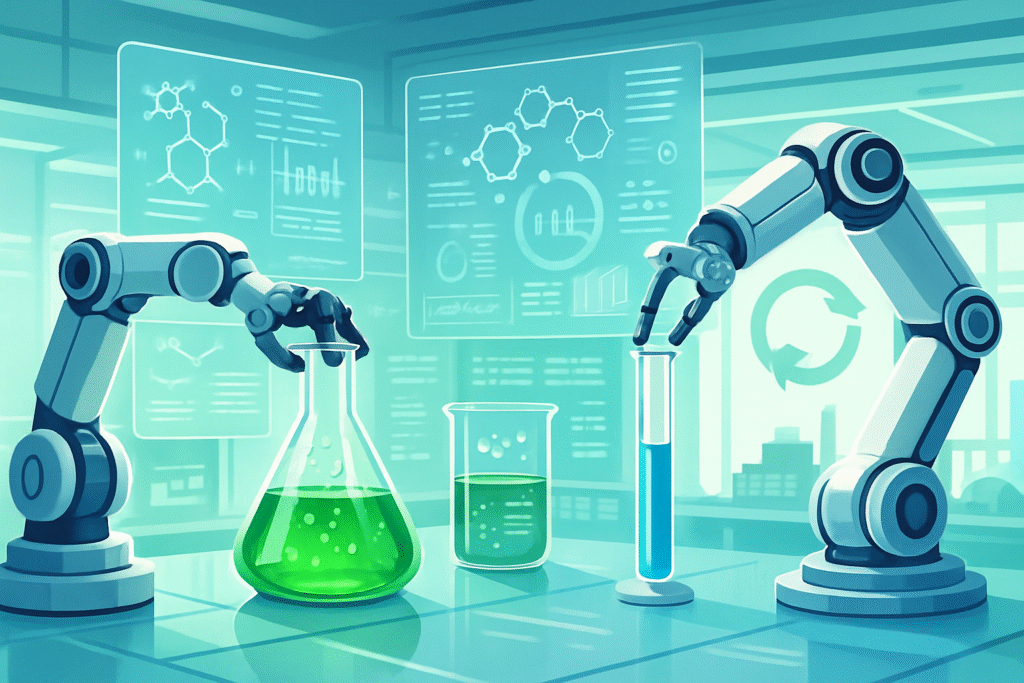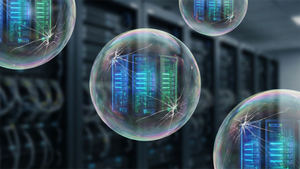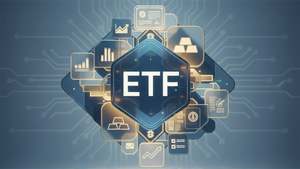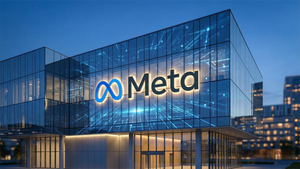
Valencia, Spain – October 16, 2025 – A groundbreaking AI-powered robotic platform, "Reac-Discovery," developed by the Universitat Jaume I (UJI), is dramatically accelerating the transition to sustainable industrial practices. This innovative system, integrating artificial intelligence, automation, and 3D printing, has been shown to slash the chemical process design time for catalytic reactors from traditional months or even years down to mere days. This unprecedented speed is poised to revolutionize green chemistry, offering a powerful tool to harmonize industrial productivity with urgent environmental responsibility.
The immediate significance of Reac-Discovery lies in its ability to rapidly prototype and evaluate reactor designs, minimizing resource consumption and optimizing chemical reactions for sustainability. This breakthrough directly addresses the critical need for faster development of environmentally benign chemical processes, particularly in the context of transforming greenhouse gases like carbon dioxide into valuable industrial feedstocks. By streamlining continuous-flow catalysis, the UJI platform offers a compelling model for future chemical research and industrial processes, making them vastly more efficient, ecologically responsible, and economically viable.
Unpacking the Technical Marvel: Reac-Discovery's AI-Driven Edge
The Reac-Discovery platform is a semi-automated digital framework built upon three core modules: Reac-Gen, Reac-Fab, and Reac-Eval. Reac-Gen employs computational design algorithms to digitally conceive and optimize reactor geometries for specific catalytic reactions. Following this, Reac-Fab utilizes advanced 3D printing to fabricate these digitally defined reactor architectures, featuring sophisticated open-cell structures and interconnected pores that significantly enhance mass and heat transfer compared to conventional designs. The final module, Reac-Eval, is responsible for the autonomous testing and self-optimization of reaction conditions, allowing for rapid iteration on configurations and catalytic parameters without human intervention.
The AI advancement within Reac-Discovery centers on its ability to autonomously conduct experiments, analyze results in real-time, and make informed decisions on subsequent steps, including optimizing reaction conditions and identifying parameters for industrial scale-up. This "closed-loop" optimization framework integrates data-driven insights with physicochemical knowledge generation, capable of translating product discovery into industrial applications. While specific robotic components are not extensively detailed, the system's innovation lies in its AI-guided autonomous operations, enabling it to process and optimize the synthesis of numerous molecules much faster than traditional human-led methods, potentially handling 10 to 20 molecules in a week.
This approach dramatically differs from previous chemical process design methods. Traditional design often relies on time-consuming, costly trial-and-error experiments, which Reac-Discovery replaces with rapid, AI-driven iteration. Unlike simpler automation that follows predefined protocols, UJI's platform integrates intelligent optimization algorithms that adapt and learn from experimental data in real-time, making informed decisions akin to a human chemist but at an exponentially faster pace. Furthermore, its explicit focus on designing sustainable chemical processes sets it apart, directly addressing modern environmental challenges. Initial reactions from the broader AI research community and industry experts indicate enthusiasm for such integrated AI and robotic systems, recognizing their critical role in ushering in a new era of efficiency, innovation, and sustainability in chemical process design.
Competitive Landscape: Who Stands to Gain?
The advent of AI-powered robotic platforms in green chemistry is poised to significantly reshape the competitive landscape across various industries. Specialized AI companies and innovative startups are at the forefront, developing core technologies. Firms like Chematica (now Synthia), IBM RXN for Chemistry (NYSE: IBM), and DeepMatter's DigitalGlassware are already leveraging AI for greener synthesis and reaction optimization. Startups such as Kebotix, Dunia Innovations, and Lila Sciences are building self-driving labs and integrating AI with autonomous robotic systems for accelerated materials discovery, including applications in green energy and carbon capture. Companies like Entalpic, Imperagen, and Dude Chem are specifically focusing on AI-driven eco-friendly chemical discovery and enzyme engineering. Haber in India and P2 Science Inc. are investing in AI Green Chemistry R&D labs to deliver sustainable chemical solutions, while Orbital Materials is developing machine learning models for green materials.
Tech giants are also recognizing the strategic importance of green chemistry for internal R&D and new market opportunities. IBM (NYSE: IBM) has collaborated on sustainable packaging, Microsoft (NASDAQ: MSFT) released MatterGen for stable material discovery, and Meta's (NASDAQ: META) Open Catalyst Project aims to find low-cost catalysts for energy storage. Semiconductor giants like Intel (NASDAQ: INTC), TSMC (NYSE: TSM), and Samsung (KRX: 005930) are deploying AI to optimize chip design and manufacturing for energy efficiency, waste reduction, and water conservation.
Traditional chemical and pharmaceutical companies, including Solugen, Reliance Industries (NSE: RELIANCE), TATA Chemicals (NSE: TATACHEM), and UPL Ltd. (NSE: UPL), stand to benefit immensely by adopting these platforms to optimize their R&D and manufacturing processes. They can accelerate their transition to sustainable practices, reduce operational costs, and meet the growing demand for eco-friendly products. Companies embracing these technologies will gain a significant competitive advantage through accelerated innovation, disrupting traditional R&D and manufacturing. Market positioning will increasingly rely on sustainability as a core differentiator, with strategic partnerships and acquisitions becoming crucial for combining expertise and accelerating market penetration.
A Wider Lens: Broader Significance and Societal Impact
The integration of AI-powered robotic platforms into green chemistry represents a significant leap within the broader AI landscape and sustainable industrial trends. It is a critical component of Industry 5.0, which emphasizes human-machine collaboration for resilient and sustainable industrial transformation. These platforms are indispensable tools for achieving net-zero emissions and circular economy goals, vastly accelerating the development of sustainable chemical processes and optimizing resource usage across the value chain.
The impacts are wide-ranging, leading to accelerated discovery of eco-friendly materials, optimized chemical synthesis, and significant reductions in waste and energy consumption. For example, AI has helped pharmaceutical manufacturing reduce energy consumption by 25%. Robotic systems also enhance safety by reducing human interaction with hazardous chemicals. This marks a profound shift from earlier AI applications that primarily offered predictive modeling and data analysis. Modern AI, combined with robotics, moves beyond mere prediction to autonomous discovery, designing, executing, and learning from experiments, transforming traditional, slow research into an accelerated, data-driven "Design-Make-Test-Analyze" loop.
However, concerns persist, including the critical need for high-quality data, the complexity of chemical systems, and the "black box" problem of some AI models, which makes it difficult to understand their predictions. Ethical considerations regarding AI-driven decisions and their environmental/human health impacts are also paramount. The computational resources required for complex AI models also raise questions about the "sustainability of AI" itself. Despite these challenges, this development signifies a maturation of AI's capabilities, moving from assistive tools to autonomous, intelligent agents that can fundamentally transform scientific discovery and industrial processes with a strong emphasis on sustainability.
The Road Ahead: Future Developments and Expert Predictions
In the near term, AI robotic platforms like Reac-Discovery will continue to streamline reaction and catalyst discovery, enabling automated and high-throughput experimentation. AI algorithms will increasingly optimize synthetic routes and predict green chemistry metrics such as biodegradability and toxicity with greater accuracy. Sustainable solvent selection will also see significant advancements, with AI models forecasting efficacy and recommending bio-based alternatives. The focus will be on further integrating these systems to perform parallel synthesis and accelerate optimization, cutting down material costs and reducing development timelines.
Longer term, the vision is for fully autonomous laboratories and self-evolving systems where AI-powered robots can concurrently propose process recipes, perform flow synthesis, and characterize molecules in a "closed-loop" fashion. The rise of agentic AI will allow robots to reason, plan, and act independently, handling end-to-end workflows. Digital twins will enable real-time simulation and optimization of chemical processes, further enhancing sustainability. Experts predict that AI will enable "inverse molecular design," where desired properties for non-toxic, biodegradable molecules are specified, and AI designs both the molecule and its synthetic pathway. This will be crucial for advanced carbon utilization and advancing the circular economy by transforming CO2 into valuable products.
Challenges remain in ensuring data quality and availability, addressing the inherent complexity of chemical systems, and improving the interpretability and transferability of AI models. The computational resources required and ethical considerations also need continuous attention. Nevertheless, experts anticipate that AI tools for synthesis planning and predictive models will become ubiquitous and high-performing, making previously multi-year manual programs feasible within months. The trend is moving from AI as a "copilot" to autonomous agents, fostering enhanced human-AI collaboration and redefining chemistry R&D by allowing chemists to focus on higher-value tasks and creative problem-solving.
A New Era of Sustainable Innovation: The Wrap-Up
The emergence of AI-powered robotic platforms in green chemistry, exemplified by Universitat Jaume I's Reac-Discovery, marks a pivotal moment in both AI history and the journey toward sustainable industrialization. Key takeaways include the dramatic acceleration of chemical process design, enhanced efficiency and precision in experimentation, optimized reaction pathways, and the rapid discovery of sustainable materials and catalysts. These innovations are fundamentally reshaping how chemical research and development are conducted, driving significant reductions in waste, energy consumption, and environmental impact.
This development signifies a crucial convergence of AI with physical sciences and engineering, moving AI beyond purely digital realms into "physical AI." It represents a maturation of AI's capabilities, transforming basic science from a labor-intensive process into an industrial-scale enterprise. The long-term impact promises a fundamentally greener chemical industry, fostering innovation and economic growth, while shifting human roles towards more creative and complex problem-solving.
In the coming weeks and months, we should watch for further advancements in automation and autonomy within these platforms, alongside efforts to improve data availability and the interpretability of AI models. Ethical considerations surrounding AI's role and its own environmental footprint will also gain prominence. The cross-pollination of these AI and robotics advancements across various industries will be crucial, as will governmental and private sector investments aimed at accelerating green chemistry innovations. This convergence is not merely a technological trend; it is a fundamental shift towards a more sustainable and efficient future for the chemical industry, redefining productivity and inspiring new frontiers in molecular science.
This content is intended for informational purposes only and represents analysis of current AI developments.
TokenRing AI delivers enterprise-grade solutions for multi-agent AI workflow orchestration, AI-powered development tools, and seamless remote collaboration platforms.
For more information, visit https://www.tokenring.ai/.




